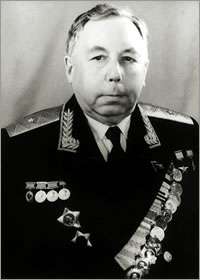Semyon Lavochkin
Semyon Alekseyevich Lavochkin (Russian: Семён Алексе́евич Ла́вочкин; September 11, 1900 - June 9, 1960), was a Soviet aerospace engineer, Soviet aircraft designer who founded the Lavochkin aircraft design bureau.[1] Many of his fighter designs were produced in large numbers for Soviet forces during World War II.[2][3]
Semyon Alekseyevich Lavochkin | |
|---|---|
 | |
| Born | September 11, 1900 |
| Died | June 9, 1960 (aged 59) Karagandy Province, Kazakh SSR, USSR |
| Nationality | Soviet Union (Russian) |
| Occupation | Engineer |
| Engineering career | |
| Discipline | Aeronautical Engineering |
| Employer(s) | Lavochkin design bureau |
Biography
Lavochkin was born to a Jewish family of teachers in Smolensk. After graduation in 1918, he enlisted in the Red Army and served in the infantry in the Russian Civil War. In 1920, he began studies at the Moscow State Technical University, from which he graduated in 1927. He then served for two years as an intern at the design department of the Central Aerohydrodynamic Institute under the direction of Andrei Tupolev, where he assisted in the design of the Tupolev TB-3 heavy bomber. While at TsAGI, his colleagues included the French seaplane designer Paul Richard, as well as Mikhail Gurevich and Nikolay Kamov.
In the early 1930s, he transferred to the Central Design Office, where he was assigned work on stratospheric aircraft, balloons and pressurized cockpits. However, as he came increasingly interested in the design of fighter aircraft, he moved to the design office of Dmitry Pavlovich Grigorovich, whom he assisted in the development of the Grigorovich I-Z fighter.
In 1938, after combat experiences in the Spanish Civil War and at the Battles of Khalkhin Gol against the Japanese, it became clear that the Soviet fighter designs were lagging behind international standards. Lavochkin established his own design bureau in 1939. Starting with the LaGG-1, he produced thousands of fighters which formed the backbone of the Soviet Air Force during the Second World War. He is especially known for the La-5 and La-7, which are among the best Soviet fighter aircraft of World War II. The top Allied ace, Ivan Kozhedub shot down 62 German airplanes, flying in fighters designed by Lavochkin. From 1941 to 1945 a total of over 22,000 Lavochkin fighters were produced.[4][5]
However, Lavochkin's fortunes faded after the war. His La-9 and La-11 were the last piston-engined fighters in Soviet service, and were replaced after a short time by jets. Although he continued pioneering work in this field (the La-176 was the first Soviet supersonic aircraft), his aircraft consistently placed second in competitions with other design bureaux, notably that of Artem Ivanovich Mikoyan.
At the end of WWII, forward thinking and competition in jet engine driven planes in Soviet Union pushed Lavochkin to start development of rocket systems. The outcome of that decision was SA-2 Guideline and a Burya. The LA-350 (Burya) is notable for the first in the world production use of Titanium and a thruster cooling by use of reverse flow of propellent.[6]
After his death, due to a heart attack during a test of an air defense system in the Kazakh SSR at the age of 59, the focus of the design office shifted to surface to air missiles (most notably the SA-2 Guideline), and to space projects.
In 1944, Lavochkin was given the honorary rank of Major-General of Engineering/Technical Service. From 1950-1958, Lavochkin also served as a deputy of the Supreme Soviet of the USSR. He also became an Academician of USSR Academy of Sciences in 1958. He died in 1960 and was buried in the Novodevichy Cemetery.
Awards and honors
- Hero of Socialist Labour, twice (1943, 1956)
- Stalin Prizes;
- 1st class (1941, 1946, 1948)
- 2nd class (1943)
- Order of Lenin, three times
- Order of the Red Banner
- Order of Suvorov 1st and 2nd classes
- Medal for Combat Service
References
- Central Museum of the Military Air Forces of the Russian Federation
- Moore, Jason (2017). Lavochkin Fighters of the Second World War. Fonthill Media. Retrieved 24 October 2017.
- "The Birth of a Soviet Design Legend". warthunder.com. Retrieved 24 October 2017.
- "Lavochkin LaGG-3". Spartacus Educational. Retrieved 24 October 2017.
- Kinville, Patrick (4 June 2017). "The Development of the Soviet Union's La-5 Fighter in WWII". WAR HISTORY ONLINE. Retrieved 24 October 2017.
- Jung, Philippe (1997). History of rocketry and astronautics. Sam Diego, CA: American Astronautics Society. ISBN 0-87703-440-0.
- Pederson, Jay. International Directory of Company Histories, Vol.24, St James Press (1998) ISBN 1-55862-365-5
- Bull, Stephan. Encyclopedia of Military Technology and Innovation, Greenwood (2004) ISBN 1-57356-557-1
- Gordon, Yefim. Soviet Air Power in World War II. Midland Publishing (2008) ISBN 1-85780-304-3